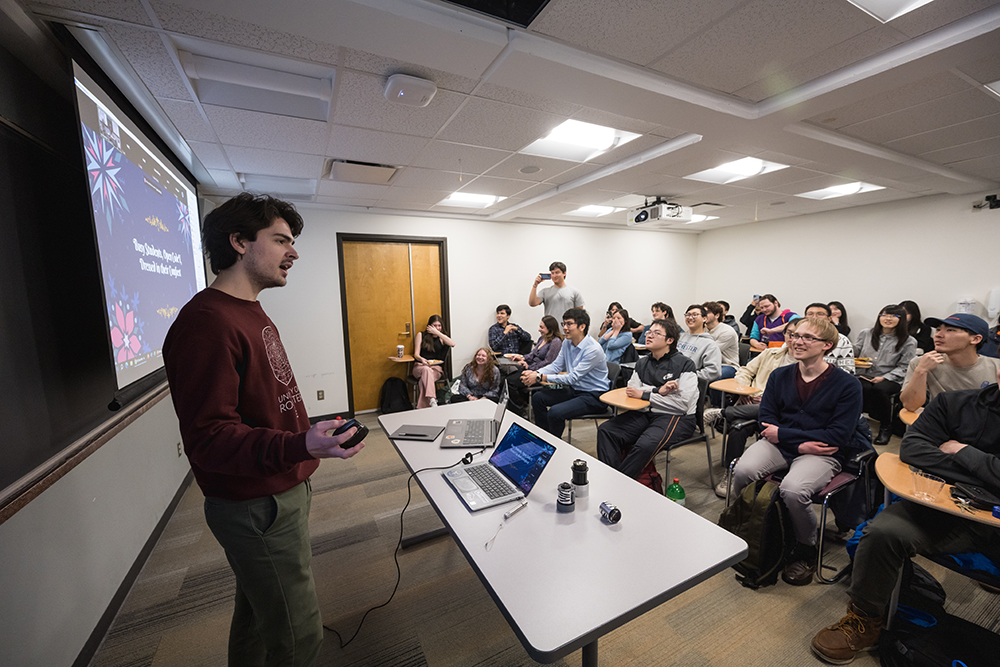Major Requirements
Optics and Optical Engineering

How Requirements Differ
Optics and optical engineering students have the same course load requirements until their senior year.
During their last year optics students will take two senior thesis courses, which will provide them with practical experience in research and crafting of a thesis that will comprehensively report their findings.
Alternatively, optical engineering students will complete two senior design courses, providing them with practical experience in applying optical knowledge to work on real-world, company-sponsored, problems.
Required Courses for Optics and Optical Engineering Majors
Optics and optical engineering majors are required to take a total of 130 credits for their degree. You can see an example of what these requirements look like mapped out over four years by visiting our sample schedule page.
In order to graduate, a “2.0” overall GPA is required, as well as a “2.0” GPA in each of the following areas:
- All attempted or completed optics courses
- MATH 16X, 14X, or 17X series
- PHYS 12X or 14X series
- All cluster courses
- WRTG 105 or authorized equivalent
For more information about requirements and policies, please review the Optics Undergraduate Handbook PDF.
Foundational Courses
OPT 211: Matlab for Optics I
Plus one of the following:
- OPT 212: Matlab for Optics Majors II (two credits)
- CSC 161: Introduction to Programming (four credits)
Plus all of the following:
- CHEM 137: Chemical Principals for Engineers*
- MATH 161: Calculus IA and MATH 162: Calculus IIA (AP scores may give credit and/or placement)
- MATH 164: Multidimensional Calculus
- MATH 165: Linear Algebra with Differential Equations
- PHYS 113, PHYS 122–123, PHYS 121–123, or Honors Physics 141-143**
- ECE 210: Circuit Analysis for System Thinking
*CHEM 137 is preferred, but students use CHEM 131: Concepts, Systems, Practice I, or an AP score of 4 or 5 to satisfy this requirement
**Honors physics does not follow the same semester sequencing plan as PHYS 12X series. Consult with your faculty advisor if you’re planning to take honors physics.
Required Core Classes
OPT 201: Geometrical Optics Lab (2 credits)
OPT 202: Physical Optics Lab (2 credits)
OPT 203: Instrumentation Lab (2 credits)
OPT 204: Sources and Detectors Lab (2 credits)
ECE 210: Circuit Analysis for System Thinking
OPT 223: Quantum Theory of Optics
OPT 225: Optical Sources and Detectors
OPT 241: Geometrical Optics
OPT 242: Aberrations and Testing
OPT 261: Interference and Diffraction
OPT 262: Electromagnetic Theory
OPT 287: Math Methods for Optics and Physics
Technical Electives
Students can think of the technical elective requirement as a “cluster.” The goal is to study an area that is of interest, but not part of the core requirements. Twelve technical elective credits are required, which is usually completed with three four credit courses.
Suggested Technical Themes
Biomedical optics:
- OPT 241: Geometrical Optics
- OPT 248: Vision and the Eye
- BME 270: Biomedical Microscopy
- BME 272: Advanced Biomedical Microscopy
Optics and math:
- OPT 287: Math Methods in Optics and Physics
- MATH 2XX
- MATH 2XX
- MATH 2XX
Lens design:
- OPT 241: Geometrical Optics
- OPT 243: Optical Fabrication and Testing
- OPT 244: Lens Design
- OPT 246: Thin Film Coatings
- OPT 247: Advanced Optical Coatings
Photonic materials/devices:
- OPT 225: Sources and Detectors
- OPT 421: Optical Properties of Materials
- OPT 246: Thin Film Coatings
- ME 280: Introduction to Materials Science
Optics and physics:
- OPT 223: Quantum Theory
- PHYS 235: Classical Mechanics I
- PHYS 227: Thermo and Stat Mechanics
- PHYS 246: Quantum Theory
Lab special:
- OPT 204: Sources and Detectors Lab
- OPT 253: Quantum and Nano Optics Lab
- OPT 254: Nanometrology Laboratory
- PHYS 243W: Advanced Experimental Techniques I
Lasers and photonics:
- OPT 225: Sources and Detectors
- OPT 465: Principles of Lasers
- OPT 468: Integrated Photonics
- OPT 466: Ultrafast Optics and Laser-Matter Interactions
Optomechanics:
- OPT 242: Aberrations and Testing
- OPT 232: Opto Mechanical
- OPT 432: Opto-Mechanical
- ME 226: Introduction to Solid Mechanics
*Any graduate course used to fulfill a technical elective requirement cannot be used for the graduate program.
Other Technical Elective Courses
Students may take any combination of STEM courses with faculty advisor approval.
Writing Requirements
All students in the Hajim School of Engineering and Applied Sciences are required to complete the primary writing requirements by taking WRTG 105 or its equivalent.
Optics and optical engineering students must also complete the following course to fulfill their upper level writing requirement:
- WRTG 273: Communicating Your Professional Identity
Cluster Requirement
All optics and optical engineering majors must complete a total of 16 credits* in humanities and/or social sciences. Three of these courses must constitute an approved cluster in humanities or social sciences and must be passed with a 2.0 average or better. See the Cluster Search Engine to review courses and descriptions.
The fourth course can be chosen from any humanities or social science course.
*A minor, or a second major, in a humanities or social science area will also satisfy the cluster and additional course requirement.
Required Classes for Optical Engineering Majors Only
Optical engineering majors must take all of the following courses:
- OPT 310: Senior Design I
- OPT 311: Senior Design II
Required Classes for Optical Majors Only
Optics majors must take all of the following courses:
- OPT 320: Senior Thesis I
- OPT 321: Senior Thesis II
Transfer Students
Typically, transfer students seeking an optics degree spend three full years at University of Rochester (MCC 2+2 students excepted). Transfer students should email Dustin Newman to review their academic history prior to transferring.
